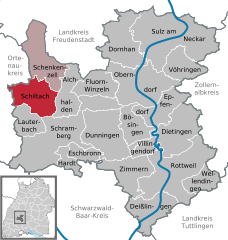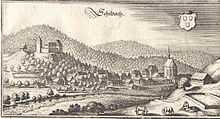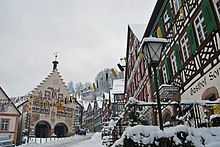Schiltach
| Schiltach | ||
|---|---|---|
| ||
 Schiltach | ||
Location of Schiltach within Rottweil district 
 | ||
| Coordinates: 48°17′26″N 08°20′41″E / 48.29056°N 8.34472°ECoordinates: 48°17′26″N 08°20′41″E / 48.29056°N 8.34472°E | ||
| Country | Germany | |
| State | Baden-Württemberg | |
| Admin. region | Freiburg | |
| District | Rottweil | |
| Subdivisions | 2 Ortsteile | |
| Government | ||
| • Mayor | Thomas Haas | |
| Area | ||
| • Total | 34.22 km2 (13.21 sq mi) | |
| Elevation | 330 m (1,080 ft) | |
| Population (2012-12-31)[1] | ||
| • Total | 3,849 | |
| • Density | 110/km2 (290/sq mi) | |
| Time zone | CET/CEST (UTC+1/+2) | |
| Postal codes | 77757–77761 | |
| Dialling codes | 07836 | |
| Vehicle registration | RW | |
| Website | www.schiltach.de | |
Schiltach is a town in the district of Rottweil, in Baden-Württemberg, Germany. It is situated in the eastern Black Forest, on the river Kinzig, 20 km south of Freudenstadt.
Geography
Schiltach lies in the eastern end of the Black Forest, at the confluence of the Schiltach and Kinzig rivers. It stands at an elevation of 330 metres (1,083 ft).[2]
Climate
Like most of Germany, Schiltach has an oceanic climate (Köppen climate classification Cfb).[2]
Town subdivisions
The town of Schiltach consists of the districts Schiltach and Lehengericht. The two districts are geographically identical to the previously independent municipalities of the same name.
The district Schiltach includes the city of Schiltach, the villages Grumpenbächle and Vorderheubach and the settlements Auf der Staig, Blattenhäuserwiese, Grumpen and Kuhbacherhof (Vor Kuhbach). The ruined castle Willenburg is located in the district of Schiltach.
The village Lehengericht has its own village council, a mayor as its chairman and its own village administration.[3] The district Lehengericht also consists of the settlements and hamlets Herdweg, Auf dem Hof, Schmelzle, Vor dem unteren Erdlinsbach, Vor Reichenbächle, Welschdorf, Höllgraben, Im Eulersbach, Im hinteren Erdlinsbach, Kienbronn, Rohrbach, Rubstock, Deisenbauernhof and several isolated farms.[4]
History




The road through the Kinzigtal was already in the Roman Empire a connection through the Black Forest out of the area of Strasbourg in the direction to Rottweil.
Schiltach was founded in the 11th century as a parish for the surrounding farms, which are older than Schiltach. Around the town church, which today stands in the town district Vorstädtle and is evangelic, rose a settlement named after the river Schiltach. Probably in the middle of the 13th century the Dukes of Teck founded the town Schiltach to secure their territories. They build a town surrounding wall with gates and above the town a castle. A church was not built, because Schiltach already had one.
The town should host transients and be a service center before the gradient of the road to Rottweil. Since about 1250 the castle and town took over the function of the Willenburg, which supplied the road before the founding of Schiltach.
In 1371 Schiltach got in the hands of the Dukes of Urslingen. After ten years, the impoverished dukes of Ursling sold the castle and town to the Dukes of Württemberg. Until 1810 Württemberg held Schiltach except the years from 1519 to 1534. At first Schiltach was sieged by the Reichsstadt Rottweil and later (like the whole Duchy of Württemberg) by Further Austria.
In the "Gränzvertrag zwischen dem Königreich Württemberg und dem Großherzogthum Baden"[5] (border treaty between the Kingdom of Württemberg and Grand Duchy of Baden), which was negotiated in Paris on October 2, 1810, several areas of the Oberamt Hornberg, besides Schiltach also the town of Hornberg and the communities Gutach and Kirnbach, got to the Grand Duchy of Baden. Wolfach became the new Amststadt of Schiltach and later the county town. The surrounding farm became as Lehengericht, an own community.
In 1952, Schiltach went to the state Baden-Württemberg. The Landkreis Wolfach was dissolved in 1973, Schiltach was allocated to Rottweil. The community Lehengericht was reincorporated into the town of Schiltach in 1974. In 1979 the exclave Sulzbächle/Fischbach went to the town of Wolfach, in return the area Vor Heubach got to Schiltach.
Religions
During the Protestant Reformation, Schiltach was a part of Württemberg so it was like the territorial lords evangelic. It did not change until the 19th century, when because of industrialisation more and more Catholics moved in. Today in Schiltach exist an evangelic and a catholic community beside a new apostolic community and various minor religious communities.
- The evangelic church (Stadtkirche) was built in neo-Byzantine style after the old gothic church burned down.
- The Catholic Church St. Johannes der Täufer was blessed in 1966 as successor of the old catholic church from 1899, which had to be replaced because of its small size.
- The New Apostolic Church at the Hauptstraße comes from the 1980s. The old new apostolic church in the Schenkenzeller Straße has still the characteristic cross on the roof, but despite its bigness it is used as a residential house.
Incorporations
- 1934: Area of former Habershof
- 1936: Area Kuhbacher Hof
- April 1, 1974: Community Lehengericht
- 1979: Area Vor Heubach
Emblem

Today's town emblem was adopted of the Dukes of Urslingen. The emblem became free to use as the last Urlinger, Duke Reinhold IV. of Urslingen died in 1442. Probably it was conveyed by the Count Ludwig of Württemberg, which was a patron of the town.
The emblem shows three red shields in a white field. Almost the same emblem can be found in Alsace at the house of the Rappolstein, which castle stands above Ribeauvillé. A member of the Ursling family married into Rappolstein family.
Politics

Local council
The local council has besides the mayor 14 members, including three women. The local election took place on 7 June 2009 and had following results:
| Bund unabhängiger Wähler | 41,7% (+1,5) | 6 Seats (=) |
| CDU | 25,8% (+1,3) | 4 Seats (=) |
| Freie Wählervereinigung Schiltach | 20,9% (+0,7) | 3 Seats (=) |
| SPD | 11,6% (-3,4) | 1 Seat (-1) |
The town district Lehengericht has a Ortsschaftsrat with eight members.
Twin town
Schiltach holds a partnership with Geising in Saxony.
Economy and infrastructure
Industry
Despite its rural location the town possesses an industrial base with several internationally-known companies. Already in the time of Industrialization there were industrial areas. Schiltach had several cloth mills, which took advantage of the soft water from the two rivers; also there were multiple saw mills and tanneries for the same reason. Until the Kinzigtalbahn was built there was a timber rafting, which had to close because of the railroad. The wood from Schiltach and surroundings was partly shipped to the Netherlands on the Rhine, where it was used for ship building. Today these branches of industries have vanished except for the famous tannery Trautwein and some small saw mills. The earlier privileged timber rafting is kept alive by an active raftergroup to keep the once important industry of Schiltach in mind.
There are still some companies which were established at the turn of the century like Hansgrohe (1901), and (BBS, VEGA Grieshaber KG etc.) established later.
The industry of Schiltach provides roughly 3350 local employments, which is extraordinary because Schiltach has only roughly 4000 citizens. Also the Schiltach is topographically disadvantaged because it is in the narrowest place in the Kinzigtal and the motorways Autobahn 81 and Autobahn 5 are far away. So much the more the city fathers are more grateful for the local companies to stay at Schiltach and are willing to support the companies.
Education
The town of Schiltach has one elementary school and a Hauptschule (Nachbarschaftsschule Schiltach/Schenkenzell) with Werkrealschule. Secondary Schools are in the surrounding towns, e.g. in Schramberg, Wolfach and Hausach. There also is an evangelic and catholic kindergarten, a Waldorfkindergarten and a private day care center. The Folk High School Schiltach/Schinkenzell is an outpost of the Folk High School Schramberg.
Infrastructure
Schiltach is connected with the Bundesstraßen 294 and 462, which close the gap between Rhine and Neckar, thus also the gap between the motorways A 81 and A 5. Schiltach is traffic-calmed by a bypass. The Bundesstraße 294 directs through the 1830 m long Kirchbergtunnel and the 830 m long Schloßbergtunnel through which also the Bundesstraße 462 directs.
On workdays you can reach Freudenstadt and Offenburg with the Kinzigtalbahn every hour. At weekends single trains drive via Offenburg to Strasbourg. Besides the actual train station Schiltach has another station closer to the town centrum where all passenger trains of a private railway company stop. The Schiltach-Schramberg railway opened in 1892 was closed in 1959 for passenger trains and 1989 for cargo trains, too. Meanwhile the tracks were removed. The route is now a cycle route from Schiltach to Schramberg. Furthermore there is a very recommendable cycle route through the whole Kinzig valley from Haslach to Alpirsbach. Various bus connections in direction of Offenburg and Freudenstadt as well as a strong connection via bus to the county town Rottweil complete the traffic. There is also a handicapped accessible bus which drives almost drives to all town districts at regular intervals.
Notable places

The whole medieval inner city is under monument protection. The marketplace includes the town hall, which was designed by architect Heinrich Schickhardt and built during the Kingdom of Württemberg. There are many half-timber houses scattered throughout the town that date back to anywhere between the 16th and 19th centuries. Schiltach is part of the German Half-Timbered House Road tourist route.
A long-distance walking trail known as the Mittelweg spans the Black Forest from north to south (between Pforzheim and Waldshut), and passes through Schiltach as one stage of the trail.
The Silvesterzug is a procession that takes place in Schiltach on New Year's Eve.[6] As part of an old tradition, the citizens walk through the streets with lanterns from the marketplace to the town church and sing hymms of Pietistic origins. During the procession, the street lights of the city are turned off and replaced with pitch torches; the only electric lights to be seen are those of Christmas trees shone through the windows of private households.[6] The local pastor gives a speech from the window of the town rectory, accompanied by the performance of a choir and trombone ensemble. Afterwards, the citizens gather at the town hall, where the mayor also gives a speech.[6]
Museums

- Apothekenmuseum (former Biedermeier-pharmacy at the market place)
- Museum am Markt (Museum at the market, townhistory, Industrialization, handcraft)
- Schüttesage-Museum (Lumbering and forestry, rafter, old saw with undershot waterwheel and transmittance, tannery
- Museum Wasser - Bad - Design (The evolution of bath and bathing)
Buildings

- Townhall featuring Crow-stepped gable from 1593
- Gasthaus zum Adler (Hotel to the eagle) from 1604
- Market place
- evangelic townchurch from 1839–1843
- Gerbergase (tannery alley) with Äußere Mühle (outer mill) from 1557
- Schloßbergstraße (Road to Schloßberg)
- Städtlebrunnen (Town well) on the market place
- Jägerhäusle (hunters house) from 1590
Ruined castles

- Schiltach ruin on the Schloßberg
- Willenburg, ruin above the Staighöfe on the Schlössleberg (Little castle mountain)
- Klingenburg, ruin in Hinterlehengericht on the Burbachfelsen (Burbachrock)
Regular events
Schiltach holds several markets over the year, e.g. a farmer's market on the third Sunday in October or an artisans' market on the last Sunday in April. Besides the Schiltacher Advent and the Silvesterzug every year Fastnacht is celebrated at the time of Fasching.
Personalities
Honorary citizens
- Heinrich Baumgartner, businessman, born in 1936, honorary citizen since 1 March 2002, founder of BBS
- Bruno Grieshaber, businessman, 1919–2005, honorary citizen since 1 March 2002, founder of VEGA Grieshaber KG
- Friedrich Grohe, businessman, 1904–1983, honorary citizen since 1 March 2002, founder of Friedrich Grohe Armaturenfabrik
- Klaus Grohe, businessmann, born 1937, honorary citizen since 1 March 2002, son of Hans Grohe
Sons and daughters of the town
- Horst Neugart, born 1940 in Schiltach, since 2002 president of the synod of the Evangelical-Lutheran Church in Württemberg
| Wikimedia Commons has media related to Schiltach. |
Sources and further reading
- ↑ [Statistisches Bundesamt – Gemeinden in Deutschland mit Bevölkerung am 31.12.2012 (XLS-Datei; 4,0 MB) (Einwohnerzahlen auf Grundlage des Zensus 2011) "Gemeinden in Deutschland mit Bevölkerung am 31.12.2012"]. Statistisches Bundesamt (in German). 12 November 2013.
- ↑ 2.0 2.1 "Schiltach". DB-City. Retrieved 4 March 2013.
- ↑ Statute of Schiltach, 6 October 2004
- ↑ The state of Baden-Württemberg. Official description by districts and municipalities. Volume VI: Government FreiburgKohlhammer, Stuttgart 1982, ISBN 3-17-007174-2. P. 499-500
- ↑
- ↑ 6.0 6.1 6.2 "Der traditionelle Schiltacher Silvesterzug". Schiltach Im Schwarzwald. Retrieved 6 March 2013.
External links
| |||||||